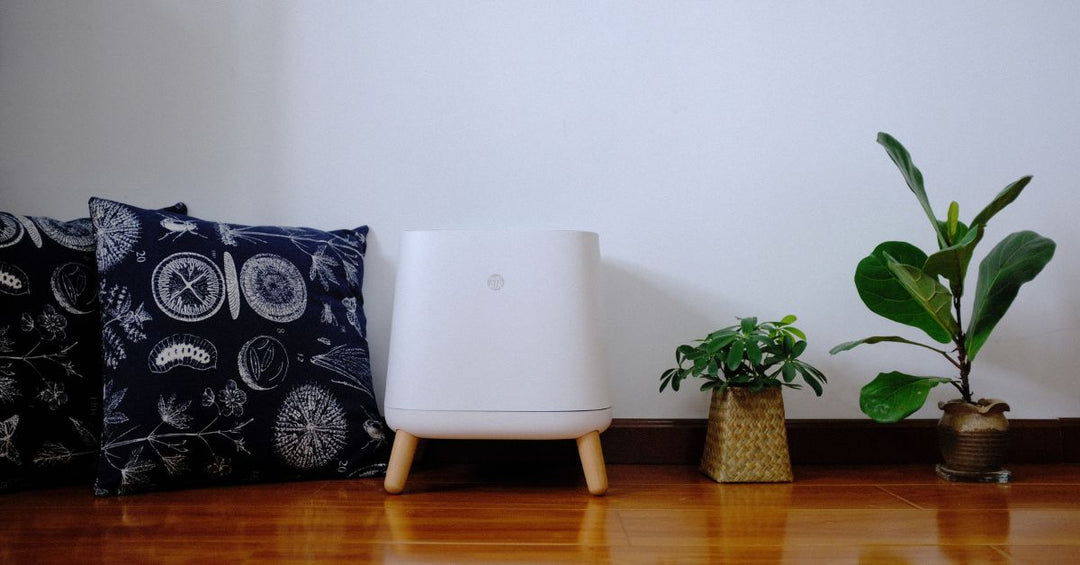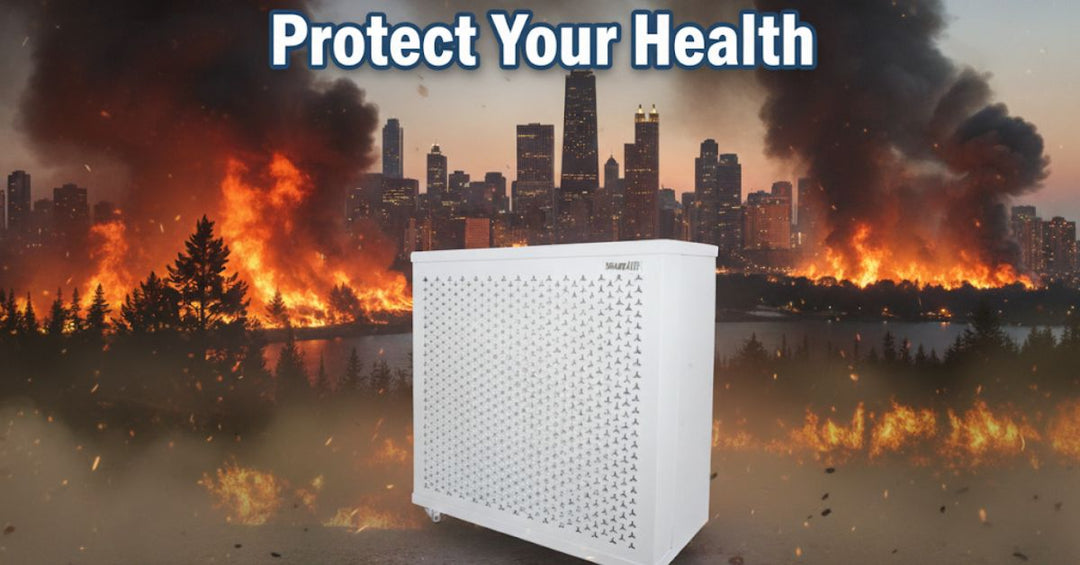What Are HEPA Filters and How Do They Work?
The term “HEPA filter” can be confusing. What does HEPA stand for? What is a HEPA filter made from, and what actually makes it a HEPA filter?
What Is a HEPA Filter?
“HEPA” stands for “high-efficiency particulate air” (filter). It sounds complicated, but HEPA air filters are nothing fancy. They were invented back in the 1940s when scientists were developing the atomic bomb, and they’re just a mat of randomly aligned fibers, made from either glass or synthetic materials. The synthetic material used in the air filter is similar to what’s used in quick-dry T-shirts.

On the other hand, fiberglass air filters are made from glass – that means things like silica, alumina, calcium oxide, boron oxide, magnesium oxide, sodium oxide.
What’s important about HEPA air filters is they’re incredibly effective at capturing almost every size of particle. They can capture viruses, bacteria, pollen, PM2.5, allergens, and more. HEPA air filters are the most important component of any air purifier.

To see what the randomly aligned mat of fibers look like, here’s a closeup of the HEPA filter Smart Air makes for The Sqair air purifier, and then alongside it a view at the nano-level with the help of a microscope.


What Makes a Filter a HEPA Filter?
OK, so if HEPA filters were invented in the 1940s, and they’re nothing fancy, then what makes any old filter a HEPA filter? Turns out using the term “HEPA” has a strict set of requirements. In Europe, HEPA filters must remove 99.95% (ISO) of particles. In the US, they must remove 99.97% of particles.
| Standard | Filtration Rate of MPPS |
| ISO / European (ISO29463 / EN 1822) | ≥ 99.95% |
| US Standard (MIL-STD-282) | ≥ 99.97% |
When following the ISO or European rules, filters that capture ≥85% of particles but less than 99.95% are called ‘EPA filters’ or ‘efficient particulate air filter’. These air filters do not meet the filtration requirement to be considered a ‘HEPA air filter’.
On the other hand, filters that exceed the requirements of a ‘HEPA air filter’ and capture more than 99.999% of particles are called ‘ULPA filters’ or ‘ultra low penetration air filter’.
| Designation | Filtration Rate |
| EPA (efficient particulate air filter) | 85% – 99.95% |
| HEPA (high efficiency particulate air filter) | 99.95% – 99.999% |
| ULPA (ultra low penetration air filter) | ≥99.999% |
OK, but what does “particles” mean? All particles? A particular size of particles? Turns out HEPAs are tested against the “most penetrating particle size” (MPPS)–more on that in a bit.
How Do HEPA Filters Work?
The answer to this question is the most fascinating thing about HEPA filters. Most of us might start out thinking HEPA filters work like a net, like this.

If a particle is smaller than the holes in the net, it gets through. Makes sense!
HEPA Filter Method 1: Large Particles
That intuition is true for big particles. By “big,” we’re talking typically larger than 1 micron. For comparison, a human hair is about 50 microns wide. So 1 micron is actually quite small.

But these “large” particles fly into a HEPA filter, they’re too big to get through, so they get stuck. Scientists have a name for that. When particles get stuck between two fibers, they call it “straining.”

HEPA Filter Method 2: Smaller Particles
What happens for particles smaller than 1 micron? Let’s look at the next size range down: 0.3 – 1 microns. We’re talking about the size of a bacteria.

Particles this size can fit between the gaps in the filter. But they have a problem. They’ll try to follow the air around a HEPA filter fiber, but they are a bit heavy. So some of them don’t move fast enough and thus end up getting stuck. Scientists call this “interception.”

HEPA Filter Method 1: Really Small Particles
OK, so do the particles below that size get through? For the really small particles (less than 0.3 microns), the science gets weirder. These particles that small have so little mass that they actually get bounced around like a pinball when they hit gas molecules (that’s called Brownian Motion). So they move in random zigzag patterns.

These particles are so small they could easily fit through HEPA filters. But sadly (for their freedom) and happily (for our lungs), they don’t fly in straight lines. Because they fly in zigzag patterns, they end up hitting the fibers and getting stuck. Scientists call that diffusion.
Here’s how all three capture mechanics work:

And here’s how the three different mechanics work for different particles sizes. Straining and impact capture large particles; interception captures medium particles; and diffusion captures the smallest particles.

What’s The Most Penetrating Particle Size For a HEPA Air Filter ?
So the larger the particle, the better a HEPA filter filters out the particle? Not so fast! Did you notice the dip in the last graph? That happens because diffusion works really well under about 0.3 microns. Straining and other mechanics that are more intuitive work really well above 0.3 microns.
Where those two mechanics intersect is the hardest particle size to capture. That’s because it’s not quite so small for diffusion to work its full strength, and it’s not quite large enough for straining to work its full strength. Call it the “weak spot” of HEPA filters. This dip in the graph is called the most penetrating particle size.

The dip in the graph most commonly occurs around the 0.3 microns mark, which is why people mention 0.3 microns all the time.
HEPA Filters Can Capture Nanoparticles
See how the line goes up to the left of the dip in the graph.

That’s Brownian motion and diffusion in action. Diffusion is incredibly effective at capturing nanoparticles. That means HEPA filters are also incredible effective at capturing nanoparticles too.
Read More: Can HEPA Filters Capture the Coronavirus?
Can HEPA filters also capture gases and VOCs?
Since HEPA filters are so great at capturing nanoparticles, it’s reasonable to think they might capture VOCs and gases too. Unfortunately this is not the case. Since gases are not particles, they move and behave differently in the air. To capture VOCs and gases you’ll need a carbon filter for that.
Read more: what combination of air filters do I need to protect myself from all pollutants? »
Can I clean a HEPA filter?
Cleaning HEPA filters with water, or vacuuming them or bashing them isn’t recommended, as it may damage the HEPA filters fibers. Smart Air tested washing HEPA filters in the Smart Air Lab. Learn more about the harms of cleaning your HEPA filter here.
Bottom line on HEPA filters
HEPA filters are high efficiency filters that typically capture over 99.5% of all particulate pollution. They’re made from either plastic (PP+PET) or fiberglass, and can capture things like pollen, viruses, bacteria, mold and PM2.5. Diffusion also means they are highly effective at capturing nanoparticles too.
Smart Air is a certified B Corp committed to combating the myths big companies use
to inflate the price of clean air.
Smart Air provides empirically backed, no-nonsense purifiers and masks, that remove the same particles as the big companies for a fraction of the cost. Only corporations benefit when clean air is a luxury.
How I Protect Myself
Smart Air is a certified B Corp committed to combating the myths big companies use to inflate the price of clean air.
Smart Air provides empirically backed, no-nonsense purifiers and masks, that remove the same particles as the big companies for a fraction of the cost. Only corporations benefit when clean air is a luxury.





